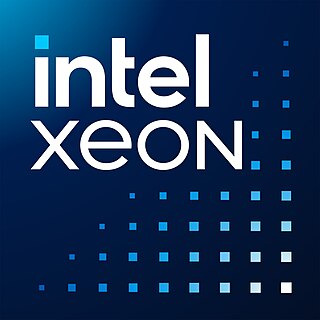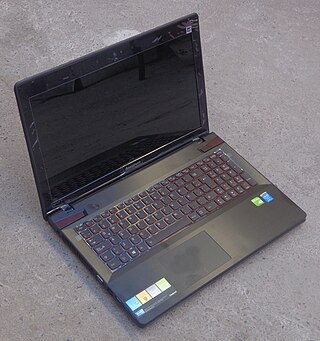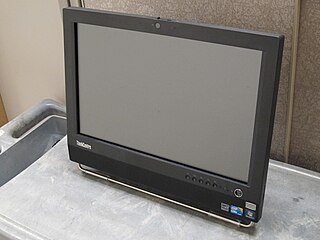
Itanium is a discontinued family of 64-bit Intel microprocessors that implement the Intel Itanium architecture. The Itanium architecture originated at Hewlett-Packard (HP), and was later jointly developed by HP and Intel. Launched in June 2001, Intel initially marketed the processors for enterprise servers and high-performance computing systems. In the concept phase, engineers said "we could run circles around PowerPC...we could kill the x86." Early predictions were that IA-64 would expand to the lower-end servers, supplanting Xeon, and eventually penetrate into the personal computers, eventually to supplant reduced instruction set computing (RISC) and complex instruction set computing (CISC) architectures for all general-purpose applications.

Xeon is a brand of x86 microprocessors designed, manufactured, and marketed by Intel, targeted at the non-consumer workstation, server, and embedded markets. It was introduced in June 1998. Xeon processors are based on the same architecture as regular desktop-grade CPUs, but have advanced features such as support for error correction code (ECC) memory, higher core counts, more PCI Express lanes, support for larger amounts of RAM, larger cache memory and extra provision for enterprise-grade reliability, availability and serviceability (RAS) features responsible for handling hardware exceptions through the Machine Check Architecture (MCA). They are often capable of safely continuing execution where a normal processor cannot due to these extra RAS features, depending on the type and severity of the machine-check exception (MCE). Some also support multi-socket systems with two, four, or eight sockets through use of the Ultra Path Interconnect (UPI) bus, which replaced the older QuickPath Interconnect (QPI) bus.

Altix is a line of server computers and supercomputers produced by Silicon Graphics, based on Intel processors. It succeeded the MIPS/IRIX-based Origin 3000 servers.
HPE Integrity Servers is a series of server computers produced by Hewlett Packard Enterprise since 2003, based on the Itanium processor. The Integrity brand name was inherited by HP from Tandem Computers via Compaq.

SGI Visual Workstation is a series of workstation computers that are designed and manufactured by SGI. Unlike its other product lines, which used the 64-bit MIPS RISC architecture, the line used Intel Pentium II and III processors and shipped with Windows NT 4.0 or Windows 2000 as its operating system instead of IRIX. However, the Visual Workstation 320 and 540 models deviated from the architecture of IBM-compatible PCs by using SGI's ARCS firmware instead of a traditional BIOS, internal components adapted from its MIPS-based products, and other proprietary components that made them incompatible with internal hardware designed for standard PCs and hence unable to run other versions of Microsoft Windows, especially Windows 9x. By contrast, the remaining models in the line are standard PCs, using VIA Technologies chipsets, Nvidia video cards, and standard components.

The IBM BladeCenter was IBM's blade server architecture, until it was replaced by Flex System in 2012. The x86 division was later sold to Lenovo in 2014.
The ES7000 is Unisys's x86/Windows, Linux and Solaris-based server product line. The "ES7000" brand has been used since 1999, although variants and models within the family support various processor and bus architectures. The server is marketed and positioned as a scale-up platform where scale-out becomes inefficient. Typically the ES7000 is utilized as a platform for homogeneous consolidation, large databases, Business Intelligence, Decision Support Systems, ERP, virtualization, as well as large Linux application hosting.

LGA 2011, also called Socket R, is a CPU socket by Intel released on November 14, 2011. It launched along with LGA 1356 to replace its predecessor, LGA 1366 and LGA 1567. While LGA 1356 was designed for dual-processor or low-end servers, LGA 2011 was designed for high-end desktops and high-performance servers. The socket has 2011 protruding pins that touch contact points on the underside of the processor.

The ThinkPad E Series is a notebook computer series produced since 2010 by Lenovo. It is the most affordable sibling in the ThinkPad family and is aimed at small business users as well as education markets.

Skylake is Intel's codename for its sixth generation Core microprocessor family that was launched on August 5, 2015, succeeding the Broadwell microarchitecture. Skylake is a microarchitecture redesign using the same 14 nm manufacturing process technology as its predecessor, serving as a tock in Intel's tick–tock manufacturing and design model. According to Intel, the redesign brings greater CPU and GPU performance and reduced power consumption. Skylake CPUs share their microarchitecture with Kaby Lake, Coffee Lake, Whiskey Lake, and Comet Lake CPUs.

The ThinkPad X series is a line of notebook computers and convertible tablets produced by Lenovo as part of the ThinkPad family. The ThinkPad X series is traditionally the range best designed for mobile use, with ultraportable sizes and less power compared to the flagship ThinkPad T series. It was initially produced by IBM until 2005.

The ThinkPad W series laptops from Lenovo were described by the manufacturer as being "mobile workstations", and suit that description by being physically on the larger side of the laptop spectrum, with screens ranging from 15.6" to 17.3" in size. Most W series laptops offered high-end quad-core Intel Core processors with an integrated GPU as well as an Nvidia Quadro discrete GPU, utilizing Nvidia Optimus to switch between the two GPUs as required. Notable exceptions are the W500, which has ATI Mobility FireGL integrated workstation-class graphics, and the W550s, which is an Ultrabook-specification laptop with only a dual-core processor. The W series laptops offered independent software vendor (ISV) certifications from various vendors such as Adobe Systems and Autodesk for computer-aided design (CAD) and 3D modeling software.
The IdeaPad Z Series is designed primarily for entry-level multimedia users. The first three Z Series IdeaPad laptops were the Z360, Z460 and Z560, with 13 inch, 14 inch, and 15 inch screens respectively. All three laptops were released in 2010.

The IdeaPad Y series was a consumer range of laptops produced by Lenovo, first announced in 2008. They were marketed as premium high performance laptops for multimedia and gaming, as part of the IdeaPad line.
The A Series desktops are part of Lenovo’s ThinkCentre product line. Formerly an IBM brand, Lenovo acquired the ThinkCentre desktop brand following its purchase of IBM’s Personal Computing Division (PCD) in 2005. The first desktop in the A Series was the ThinkCentre A50p. Lenovo has released A Series desktops in multiple form factors, ranging from traditional tower, to small form factor, and all-in-ones (AIOs).
The M-series of desktops are part of Lenovo's ThinkCentre product line. Formerly an IBM brand, Lenovo acquired the ThinkCentre desktop brand following its purchase of IBM's Personal Computing Division (PCD) in 2005. Following its acquisition of IBM's PCD, Lenovo has released M-series desktops in multiple form factors, ranging from traditional tower, small form factor, to ultra small form factor, and all-in-ones (AIOs).
In addition to the ThinkPad and IdeaPad laptops, Lenovo also offers a value-priced series of laptops. Called ‘Essential’ on the Lenovo website, the products available in this line include the G Series, B Series, and V Series. Launched in 2009, the first laptop in the Essential range was the G530.
Lenovo's line of Essential desktops is a collection of budget-conscious machines designed for consumers, and advertised as being "affordable, space saving, and energy efficient". The Essential desktop line is different from both Lenovo's ThinkCentre line and Lenovo's IdeaCentre line. Lenovo defines its ThinkCentre desktops as business-oriented computers, while the IdeaCentre desktops are meant primarily for entertainment. The Essential range of desktops can be categorized as being between the two – meant more for ordinary everyday use.

ThinkStation is a brand of professional workstations from Lenovo announced in November 2007 and then released in January 2008. They are designed to be used for high-end computing and computer-aided design (CAD) tasks and primarily compete with other enterprise workstation lines, such as Dell's Precision, HP's Z line, Acer's Veriton K series, and Apple's Mac Pro line.

The ThinkCentre Edge is a series of desktop computers from Lenovo, designed primarily for home offices and small businesses. The product series features desktops in both tower and All-in-One form factors, designed to save up to 70% desk space as compared to traditional tower desktop PCs.















